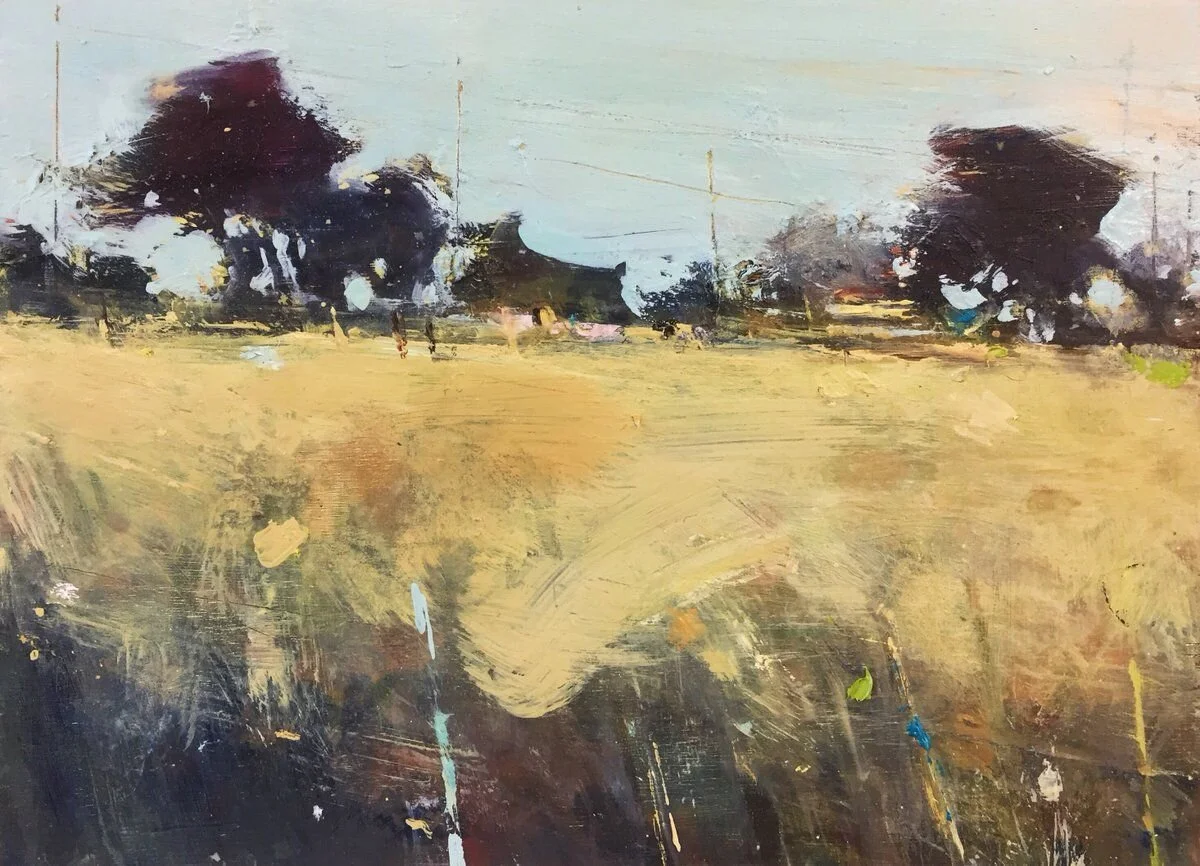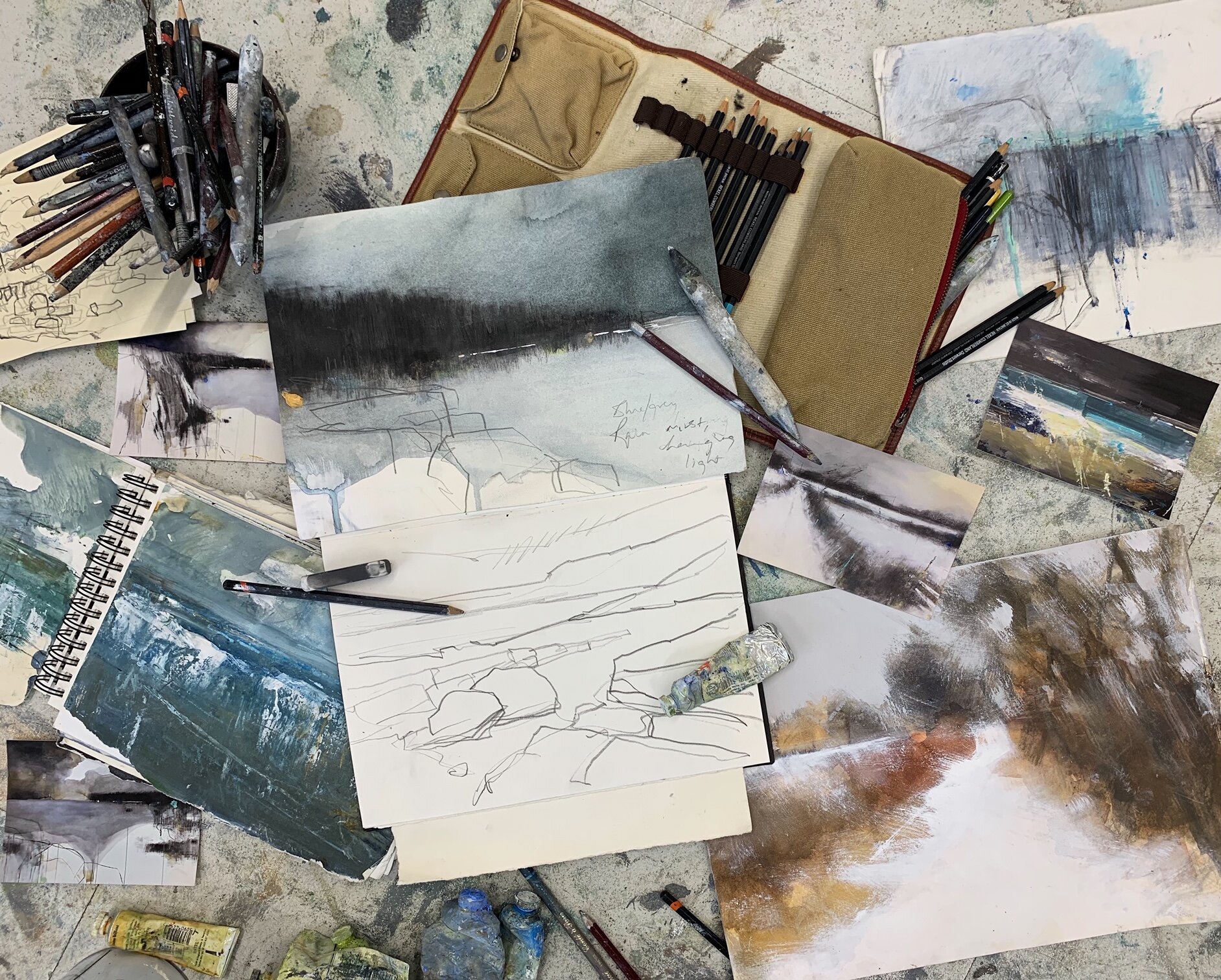Hannah Woodman
Exploring the boundaries of realism and abstraction, depiction and interpretation, Hannah Woodman shares her journey.
Hannah Woodman in the studio in Cornwall, UK.
Hannah Woodman was born in 1968 in Totnes, Devon. She studied at Exeter College of Art and Design and the Courtauld Institute of Art, London, before training to teach at the London Institute of Education. Having taught and lectured in schools, museums and galleries for six years she turned to painting full time. Since then she has had a series of sell-out solo shows and her work is now held in private and public collections, both at home and abroad. In 2018, Hannah co-founded Grays Wharf, a waterside studio complex and art centre near Falmouth, Cornwall where her studio is now based.
Tonalism.com: Do you call or think of yourself as a tonalist?
Hannah Woodman: I wouldn’t call myself a tonalist in the art historical definition of the word, but if you associate tonalism with mood created through a restricted palette and heightened use of light and dark you pretty much have my work summarised!
Tonalism.com: What is your definition of Tonalism?
Hannah Woodman: I think tonalism places atmosphere and mood above detail. By that I mean the emotional response to a subject takes precedence over the accuracy of its rendering, in particular through the use of muted tones, subdued light and effective contrast to create compositional structure.
Tonalism.com: What’s been the story of your journey as an artist?
Hannah Woodman: In some ways it’s a bit of a chequered story as I had a love/hate relationship with painting when I was younger. British art colleges in the 1980’s were fantastically experimental, but I’d had a very traditional schooling and I struggled to know what was expected of me - so much freedom was confusing! I ended up walking away from art college and taking a degree in Art History at the Courtauld Institute of Art, London University instead. This turned out to be one of the best decisions I ever made as it not only gave me a fantastic grounding (and an early career in museum and gallery education) but also an understanding of the connection between art and cultural context. I spent several years working in education, trying to open access and dismantle the notion of art as select or irrelevant. After this and when I’d had my 3 children I returned to painting, snatching moments in a makeshift home studio (i.e. shed!) to work whilst they were babies. I finally began painting full time once my youngest daughter was at school and my exhibiting career took off from there. Since then I’ve combined painting with lecturing and teaching and more recently, I co-founded an art studios complex in Falmouth, Cornwall where I live which now houses nearly 20 artists and makers.
Hannah Woodman
Tonalism.com: What are the main objectives of your current approach?
Hannah Woodman: I’m very interested in the line between abstraction and realism. I wouldn’t call myself an abstract artist - although I question that sometimes when work returns framed upside-down! - but I am interested in how far I can push expressive mark-making and still retain an identifiable subject. I’ve learnt that a minimal amount of information is required for the human eye to make recognisable associations and I play on this in much of my work to create interpretations rather than obvious depictions. One of the best compliments I get is when people tell me they see something different in a painting every time they look at it.
Hannah Woodman
Tonalism.com: What was the actual process or series of events that led you to paint as you do now?
Hannah Woodman: A slow and gradual development probably. Sometimes that development is less obvious to observers than it is to me, as it may come from a single, random mark made on one day that then characterises many other paintings afterwards. In truth, inspiration, technique and interpretive style come from a fusion of so many things over time it’s hard to pin it down in words. I don’t know any other way to paint at the end of the day!
Hannah Woodman
Tonalism.com: Please describe a little bit of your painting process?
Hannah Woodman: I work mainly on gesso primed ply board as I like the resistance of board over canvas. I’m quite a physical painter and tend to scrape and re-work quite vigorously so the more resilient the surface the better. I draw a very rough initial sketch and paint a warm under-base first, before blocking in and roughly building up layers of colour and texture with both brush and palette knife. For me, the final layer is the most important where I can be more spontaneous and gestural, allowing the previous marks and layers of colour to show through and exploring different tones and marks in a more abstracted way. I sketch a lot outdoors, but I always work these up back in the studio where I can stand well back and take the time to let the piece evolve. I find that early on I’m leading a painting, but some of the most interesting pieces begin to lead me after a while as my looser, abstracting approach is organic and intuitive and almost impossible to predict. In terms of pigments I use Old Holland and Michael Harding paints and I find I’m always running out of Red Gold Lake and Raw Umber.
Hannah Woodman
Tonalism.com: Can you describe how you decide on a composition, what makes it feel 'right' to you?
Hannah Woodman: Again, it’s a very intuitive process. I love a high horizon line, which is probably something to do with growing up in the south west of England where so many rural scenes are characterised by lanes and high hedges disappearing into the distance. I also often favour a square composition format which is less traditional. The challenge is retaining a sense of vastness within the confines of 4 edges so I try to construct compositions that allow the landscape or seascape to roll off under a distant sky rather than cropping it in too closely.
Tonalism.com: How do you know when a painting is complete?
Hannah Woodman: This is a difficult one and I would say it's the hardest part of the painting process for me - not to overwork or overthink a piece. For me, it's complete when the impact supersedes the desire to correct detail....if that makes sense.
Tonalism.com: Could you name any specific influences on your work?
Hannah Woodman: There are so many artists I can think of who have inspired me - Turner, Anselm Kiefer, Emile Nolde, Whistler, Abstract Expressionists such as Franz Kline…and I love the work of contemporary Scottish painter Peter Doig. I find his painting ‘Echo Lake’ particularly haunting - the composition shows a policeman standing on the far side of a lake at night calling out across the water while we, the viewer, take on the disconcerting role of the subject of his attention. The piece is full of questions which seem to hang in the air and this, coupled with the very murky palette of purples and greens, makes it a very evocative image.
In terms of books, a real bible for me as a landscape painter is Christopher Neve’s ‘Unquiet Landscape’. It’s a fascinating look at how artists use the landscape to filter emotion and states of mind and is not so much an art historical study as a consideration of the links between building a visual language to reflect an inherent sense of place. It’s also the closest I’ve come to seeing an explanation in print of why artists paint this subject.
Tonalism.com: Any advice for the aspiring painters?
Hannah Woodman: My general recommendation for any aspiring artist is to make a mark every day if you can. It’s not until you immerse yourself in the process and gain a rhythm that you can make any headway with developing your own painterly language - interruption is the enemy of creativity. Oh, and on a practical level stand back; there’s nothing like viewing your work from a distance to cut through the detail and nail what really completes the image.
Hannah Woodman
Tonalism.com: Saving the big question for last: What is art’s purpose in the world?
Hannah Woodman: I think art’s purpose in the world is to reflect what makes us human. All the sensitivities, desires, losses, wars, politics, mistakes and achievements we’ve made as a civilization are chronicled in the art of the past. As an artist I know that what I produce is a distillation of memory, emotion and experience and I’ve shaped a language to express this that wouldn’t be possible in any other format. I like to think that when I’m long gone my paintings will tell people far more about me than anything or anyone else could.
Hannah Woodman







